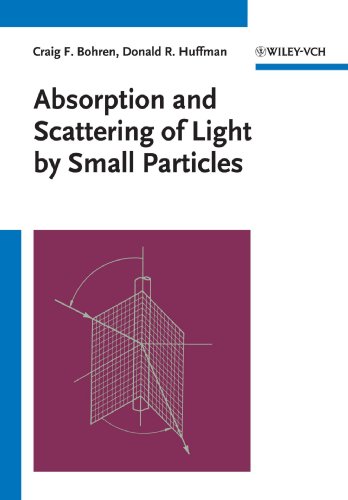Absorption and scattering of light by small particles pdf
Par peterson marisol le mardi, décembre 29 2015, 20:15 - Lien permanent
Absorption and scattering of light by small particles by Craig F. Bohren, Donald R. Huffman


Absorption and scattering of light by small particles Craig F. Bohren, Donald R. Huffman ebook
Publisher: John Wiley & Sons
Format: djvu
ISBN: 047105772X, 9780471057727
Page: 533
Subatomic particles are the particles smaller than an atom. Optical tweezers—devices that use lasers to trap and move micrometer-sized objects such as biological cells and particles of inorganic material—have revolutionized fields such as biochemistry, cell biology, and materials engineering. It is non-irritating and non-allergenic, therefore it is claimed to be very suitable for Because of its small particles, the nano size Zinc Oxide does not scatter light and therefore does not appear white. Mermin: Solid State Physics (Harcourt College Publishers, Orlando, FL, 1976) p. Scattering in tissue is the main reason tissue is not transparent; absorption also plays a role but much less so. Huffman: Absorption and Scattering of Light by Small Particles (Wiley, New York, 1983) p. There are two types of subatomic particles: elementary particles, which are not made of other particles, and composite particles. When used as an ingredient in sunscreen, Zinc Oxide, a mineral powder, is claimed to sit on the skin's surface scattering and absorbing ultraviolet rays without being absorbed into the skin. Is broadly found in nature, for example among butterflies: Arrays of very small particles can also appear coloured without absorption by causing wavelength-dependent optical interference, refraction, and light scattering. This happens most often to short wavelengths of light like blue, remember, I said that the smaller, high frequency wavelengths of light are the colors which get thrown around the most by particulate matter in the atmosphere, that they are the pushovers. When the different wavelengths of light hit these different particles, some of the colored light is absorbed and then re-dispersed and scattered all about. Perfusing tissue with a substance to match Scattering in tissue is dominated by Mie scattering which is the scattering of light by particles of a size on the same order as the wavelength of light (Rayleigh scattering is for particles much smaller than the wavelength): cells, nuclei, and organelles all fit in this category. When the wavelength of light is of the similar order as the dimensions of particles of the medium that it passes through, the photons get scattered or absorbed. More Particles Predicted – 23. 1895: Discovery of the ultraviolet radiation below 200 nm, named vacuum ultraviolet (later identified as photons) because it is strongly absorbed by air, by the German physicist Victor Schumann. Impact of brown and clear carbon on light absorption enhancement, single scatter albedo and absorption wavelength dependence of black carbon D. Bohren's treatise on Absorption and Scattering of Light by Small Particles (coauthored with Huffman) is most definitely the resource for looking at detailed physics and mathematics associated with scattering.
The Definitive Guide to ImageMagick (Definitive Guide) pdf
Attachment in Psychotherapy download
Dragons of Desolation (Dragonlance module DL4) pdf download